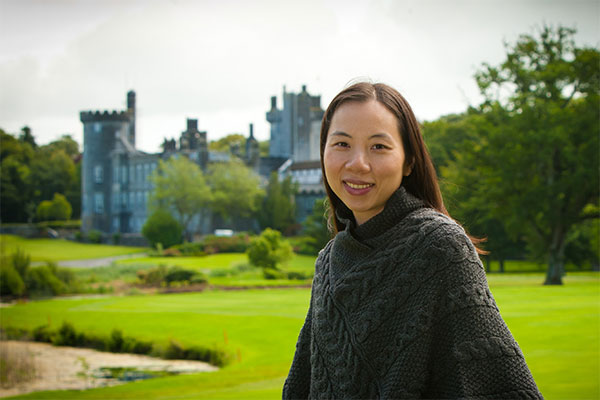 March 23, 2016 — From wind turbines and solar power to fuel cells and hydroelectricity, sources of sustainable energy are as diverse as the researchers working in this area. Professor Aimy Bazylak (MIE), Director of U of T Engineering’s Institute for Sustainable Energy (ISE), sees this diversity as a strength of both the Institute and the field.
March 23, 2016 — From wind turbines and solar power to fuel cells and hydroelectricity, sources of sustainable energy are as diverse as the researchers working in this area. Professor Aimy Bazylak (MIE), Director of U of T Engineering’s Institute for Sustainable Energy (ISE), sees this diversity as a strength of both the Institute and the field.
Next year, ISE will move into its new home on the eighth floor of the Centre for Engineering Innovation & Entrepreneurship, increasing opportunities for cross-disciplinary collaboration that will catalyze energy solutions for the future.
Q: What was the motivation for creating ISE?
A: Department of Mechanical & Industrial Engineering professors Jean Zu and Olivera Kesler and Dean Cristina Amon laid the groundwork for the ISE back in 2010, and in 2013 David Sinton transformed us into a Faculty-wide Institute. The idea was to elevate and showcase the world-class research into sustainable energy that is going on at U of T. We wanted to build new relationships with our industry partners and attract the top students who are looking to make a difference in sustainability.
Today we have more than 50 faculty members, including geographers, mathematicians and policy experts. Partnerships from outside our Faculty are critical for us because the most challenging problems in clean energy don’t confine themselves to one discipline — you really need the expertise that everyone brings to the table.
Q: Can you give an example of a project that relies on collaboration?
A: One of our projects involves Professor Mary Pugh from the Department of Mathematics, working with Professor Francis Dawson in The Edward S. Rogers Sr. Department of Electrical & Computer Engineering. Together, they are looking at the molecular-scale changes that happen within a battery as it cycles, with the ultimate goal of improving its lifetime. As a mathematician, Professor Pugh is able to bring new tools to integrate into Professor Dawson’s computer models, which will result in improved understanding and better batteries.
Q: What else are ISE researchers working on?
A: It’s hard to capture everything because we really do have stellar researchers in all areas, from the device level to the systems level. But here are some examples:
- Professor Tim Bender (ChemE) and Professor Ted Sargent (ECE) are looking at new materials — organic solar cells and quantum dots — that can increase the efficiency of solar power while reducing cost.
- Professor Geoffrey Ozin (Chemistry) was recently awarded a Connaught Global Challenge Award to develop chemical catalysts that can produce fuels from carbon dioxide. These fuels would be carbon-neutral, but could be used with existing infrastructure.
- Professor Amy Bilton (MIE) studies sustainable systems integration — for example, using passive solar aerators to improve the productivity of fish farms, making this important food source more sustainable.
There are many other examples: my own research looks at fuel cells for automotive transportation. We also have experts such as Professor Tamer El-Diraby (CivE), who is studying how to design more sustainable communities within cities.
I’m a total believer in having a portfolio of different technologies. That’s not because I’m hedging my bets; it’s because community needs vary so widely. Toronto is different from Prince George, B.C., so you can’t say that everyone needs the same thing. And when we’re all doing amazing work in different areas, we get the unexpected discoveries that lead to transformative development.
Q: How does the ISE build robust and diverse industry partnerships?
A: One initiative I’m really excited about is our third-annual Research Symposium, which will take place on March 29. In the past, we’ve showcased work from our students and faculty, which was great, but this year we’ve turned the tables a bit: we invited prominent industry partners to talk about the challenges they face.
Our guests include partners from major engineering firms like H.H. Angus & Associates Ltd. and Hatch, as well as energy companies such as Constant Power, who will will talk about how energy can be delivered in more sustainable ways. We want to open up the discussion and see what tools ISE faculty members have that can be used to address those problems.
As academic researchers, we are able to ask and answer questions that industry may not have time to ask because they have to stay focused on the next product cycle. It’s in asking those unusual questions and challenging what we already know that we get those game-changing insights.
Q: What will the ISE’s new home in the CEIE mean for you?
A: The CEIE will be a springboard for the ISE to strengthen and enrich our collaborative ties across campus by providing a common physical space for our faculty and students to meet and work together. By bringing our ISE community together, the CEIE will provide an exciting new platform for the cross-pollination of ideas that will lead to new discoveries for clean energy and sustainability.
Q: What’s the best part of leading ISE?
A: I get enormous gratification from facilitating the growth of people around me. Every day our students are taking intellectual risks and asking exciting questions. What I love is connecting those minds with companies or investors who have an interesting idea and helping all of them to realize their vision together.
In the coming years, I’d really like us to build on the expertise we have and construct even stronger teams and sub-groups to take on interesting problems in partnership with industry. By strengthening these relationships, growing the community from within and working together, we have the opportunity to really build a vision and shape the potential of clean energy, both in Canada and abroad.